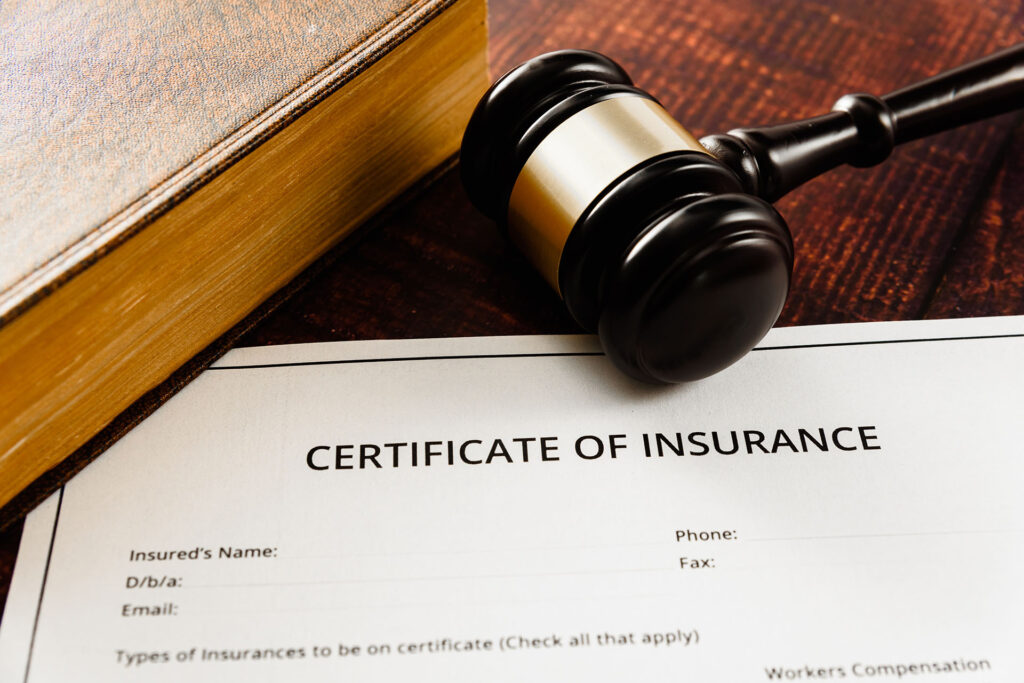Yes, insurance can cover ceiling collapse in New York, but coverage depends on the specific policy terms and the cause of the collapse. Homeowners and renters should review their policies to understand the extent of their coverage.
Ceiling collapse incidents in residential and commercial properties in New York are significant due to the potential for extensive property damage and personal injury.
Given New York's mix of older buildings and severe weather conditions, regular maintenance and a clear understanding of policy terms are essential to mitigate risks and handle claims effectively.
What Constitutes a Ceiling Collapse
A ceiling collapse refers to the sudden and often unexpected falling of a ceiling or parts of it within a building. This can manifest in two primary forms:
- Partial Collapse: This occurs when only a section of the ceiling falls, leaving the rest intact. An example of a partial collapse might be a localized failure where a portion of plaster or drywall comes loose and falls, perhaps due to a water leak or a structural defect.
- Complete Collapse: When the entire ceiling structure falls down, potentially causing extensive damage and posing severe risks to occupants. A complete collapse might occur due to severe structural issues, prolonged water damage, or a sudden overload on the ceiling structure.
Ceiling collapses, unfortunately, are more common than you might think, often resulting from long-term structural issues.
On August 1st, 2004, a section of the roof over an instructional space at Taft Elementary School in the Washingtonville CSD collapsed.
The incident involved the bar joists, roof decking, membrane roofing, and the plaster ceiling, all of which came crashing into the room below. Fortunately, no one was injured, but the outcome could have been dire if the room had been occupied at the time.
A structural engineer determined that the collapse occurred due to long-term water exposure affecting the structural steel bar joists. The building, constructed in 1960, used a "U" shaped channel for the top chord of the bar joists, a design that differs from the open steel angles used in modern joists.
Contact our personal injury lawyer in Brooklyn today for expert advice on whether you have a roof collapse claim

Is Ceiling Collapse Covered by Insurance?
Whether a ceiling collapse is covered by insurance depends on the specific terms and conditions of the policy in question. Generally, both homeowners and renters insurance can provide coverage for ceiling collapses, but the extent of coverage varies based on the cause of the collapse and the policy details.
Renters' Insurance
Renters' insurance generally covers personal property damage resulting from a ceiling collapse but does not cover the structure itself. The building's structural elements are typically the landlord’s responsibility and would fall under their property insurance.
Renters' insurance may include:
- Personal Property: Coverage for personal belongings damaged by a ceiling collapse due to covered perils. A policy might state: "This policy covers personal property loss or damage caused by fire, smoke, or water escape."
- Temporary Living Expenses: If the rental becomes uninhabitable due to a ceiling collapse, renters insurance can cover additional living expenses. For example, "We cover additional living expenses if your residence is rendered uninhabitable due to a covered loss."
Homeowners' Insurance
Homeowners' insurance typically covers ceiling collapses under the following circumstances:
- Covered Perils: If the collapse is due to a peril explicitly covered by the policy, such as fire, vandalism, or certain types of water-related damage (e.g., from a burst pipe). For example, a policy might state, "This policy covers sudden and accidental damage caused by fire, lightning, or water escape from plumbing systems."
- Structural Failures: Some policies may cover collapses resulting from hidden structural defects or issues not visible during routine maintenance. An example clause might read, "Coverage includes structural collapses due to latent construction defects or material failures."
However, there are exclusions to be aware of:
- Negligence: Damage resulting from neglect or lack of maintenance is usually not covered. A typical exclusion clause might say, "This policy does not cover damage resulting from the insured's failure to maintain the property adequately."
- Wear and Tear: Gradual deterioration over time is often excluded. For instance, "Damage from wear and tear, gradual deterioration, or inherent vice is not covered."
Additional reading: my apartment ceiling caved in, what are my rights
What Influences Your Insurance Coverage for Ceiling Collapse?
The coverage of a ceiling collapse by an insurance policy is influenced by several key factors:
- Identified cause of the collapse
- Type of insurance you hold
- Your adherence to maintenance and upkeep responsibilities
- Specific terms and conditions of your policy
Let's take a look at these in more detail to see how they can influence your insurance coverage after a collapsed ceiling:
Cause of Collapse
Insurers typically distinguish between covered and non-covered causes:
- Water Damage: Insurance may cover ceiling collapses due to sudden and accidental water damage, such as from a burst pipe. However, damage resulting from long-term leaks or neglect is usually not included.
- Structural Failure: Collapses due to hidden structural defects or construction flaws might be covered if they are not due to wear and tear or poor maintenance.
Proper maintenance and timely reporting of issues are vital to prevent claim denials. For example, if you notice signs of water leaks or structural cracks, address them immediately. Regular inspections and maintenance can help ensure that problems are identified and fixed before they lead to significant damage.
Practical Advice for Maintaining Coverage:
- Regular Inspections: Conduct regular checks of your property, looking for signs of water damage, such as stains, mold, or dampness, and structural issues like cracks in the ceiling or walls.
- Timely Repairs: Fix problems as soon as they are discovered to prevent them from worsening.
- Documentation: Keep records of all maintenance and repairs. This documentation can be crucial when filing a claim.
By proactively maintaining your property and addressing issues promptly, you can increase the likelihood of your insurance covering a ceiling collapse.
Type of Insurance Policy
The type of insurance policy you have—either all-risk or named perils—affects the coverage of ceiling collapses:
- All-Risk Policies: These policies cover all causes of damage unless explicitly excluded. This means a ceiling collapse would be covered unless the cause is listed as an exclusion in the policy. For instance, a collapse due to an unforeseen structural defect would generally be covered.
- Named Perils Policies cover only the specific perils listed in the policy. If the cause of the ceiling collapse is not listed, it won't be covered. For example, if your policy lists fire, theft, and vandalism but not water damage, a collapse due to a burst pipe would not be covered.
Liability
Liability coverage in insurance policies protects property owners and tenants from financial responsibility if someone is injured or property is damaged due to a ceiling collapse.
- Property Owner: If a ceiling collapses in a rental property due to a maintenance issue and injures a tenant, liability coverage can help cover medical expenses and legal fees.
- Tenant: If a tenant's actions, such as improper installation of heavy fixtures, cause a ceiling collapse, liability coverage under rental insurance can protect the tenant from being financially responsible for the damage.
Policy Exclusions
Insurance policies often include exclusions that can affect coverage for ceiling collapses:
- Neglect: Damage resulting from a lack of maintenance or neglect is typically not covered. For instance, if a ceiling collapses due to long-term water damage that was not addressed, the claim may be denied.
- Pre-Existing Conditions: Damage from conditions that existed before the policy was purchased is usually ruled out.
- Specific Perils: Policies may exclude certain perils, such as earthquakes or floods unless additional coverage is purchased.
Additional reading: how much should I settle for negligence ceiling collapse
How to Handle Ceiling Collapse Insurance Claim Denial
If your insurance claim for a ceiling collapse is denied, here’s a detailed guide on how to handle a claim denial effectively:
- Understand the Reason for Denial: Read the denial letter carefully to understand why your claim was denied. Compare the reasons with your insurance policy's terms and conditions.
- Gather Additional Documentation: Collect all relevant documents, including maintenance records, photos of the damage, inspection reports, and communication with contractors. Obtain an independent assessment from experts if possible.
- Appeal the Denied Claim: Write a formal appeal letter addressing the reasons for the denial and providing additional evidence. Include all relevant documentation and expert reports to strengthen your case.
- Seek Professional Help: Consider consulting your insurance agent, an independent insurance adjuster, or hiring a public adjuster to help negotiate with the insurance company.
- Legal Advice: If your appeal is denied, consult an attorney specializing in insurance claims. Explore alternative dispute resolution methods like mediation or arbitration if included in your policy.
Need Assistance with a Ceiling Collapse Claim? We Can Help
If you're struggling with a ceiling collapse insurance claim, don't hesitate to seek help. Our personal injury lawyer in Queens can make a significant difference in achieving a successful resolution.
Our team is here to help you deal with insurance companies by scheduling a free consultation to determine the best possible outcome for your situation.
Contact us today for expert advice and support to ensure you get the coverage you deserve.



